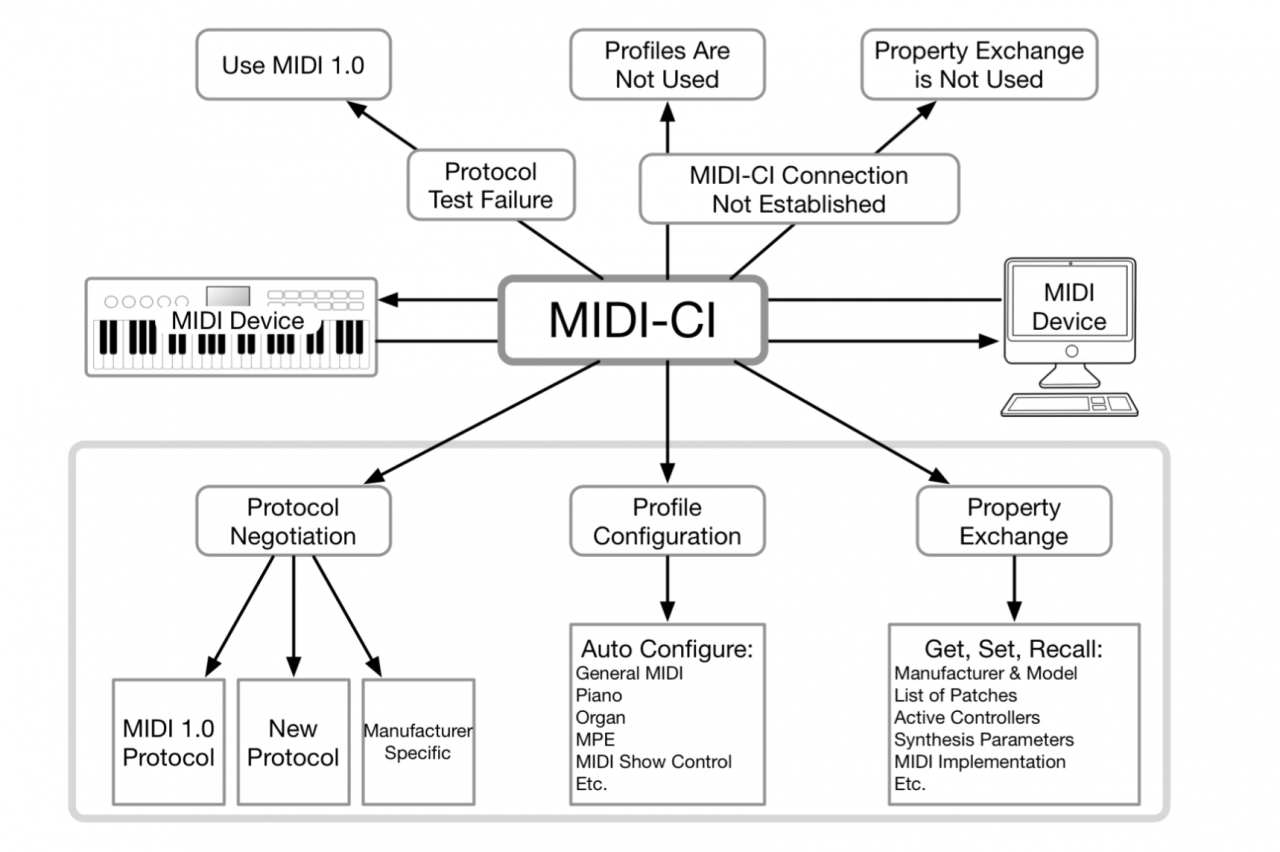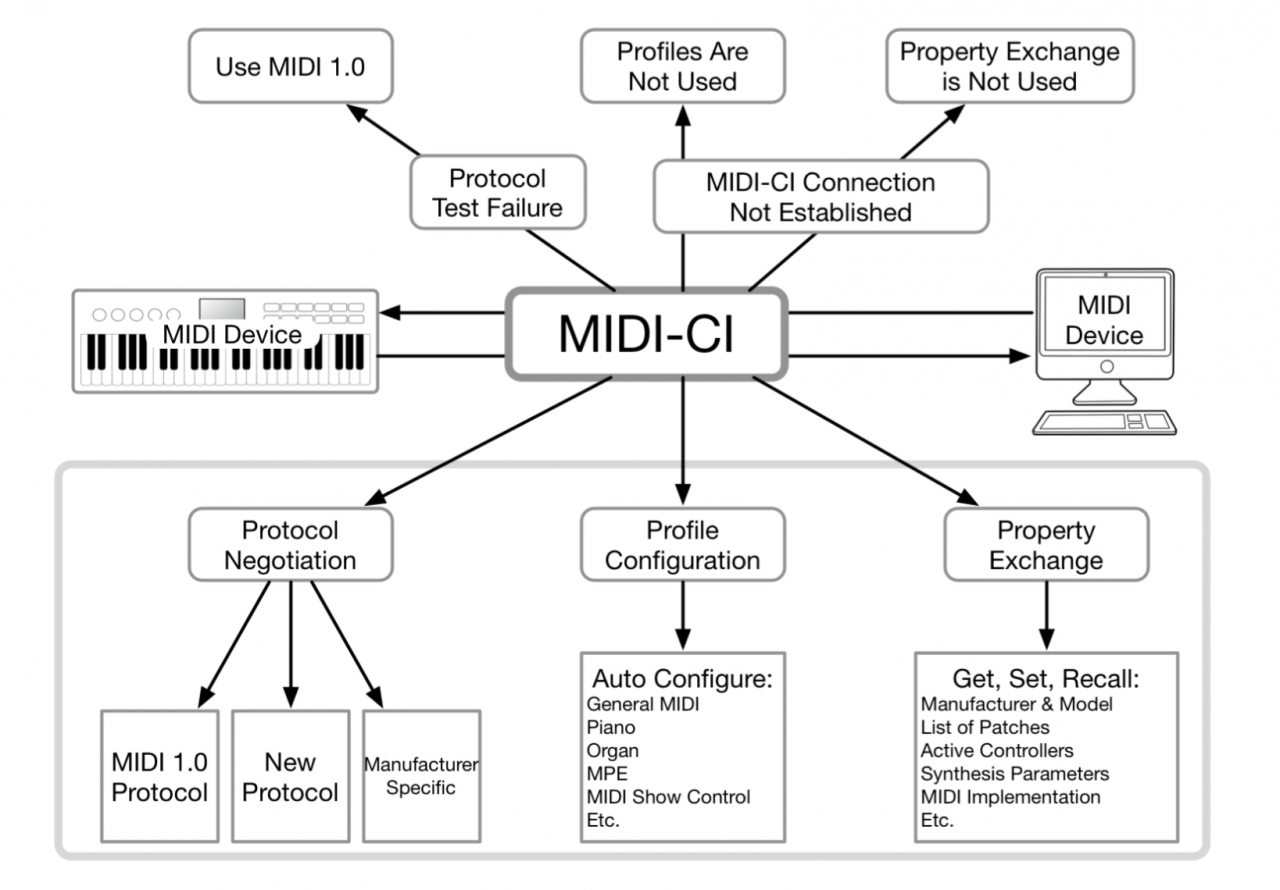MIDI Capability Inquiry Presentation at ADC

New MIDI Possibilities Outlined at ADC 2017
At the Audio Developers Conference in London, Ben Supper from Roli outlined a new MIDI proposal called MIDI Capability Inquiry ( MIDI-CI) which outlines a path to future expansions of MIDI.
Almost exactly a year ago AMEI (the Association of Music Electronic Industries and the Japanese MIDI standards organization) announced that they had established a working group to look at new possibilities for future MIDI expansions. The initial ideas for what AMEI calls MIDI-CI were developed by Mike Kent of MK2image working as a consultant for Yamaha. Mike worked for many years for Roland R&D where he helped craft the USB-MIDI specification that is still in use today. He is also a former Chairman of the MIDI Manufacturers Association Technical Standards Board (MMA TSB).
At the ADC meeting last week, Ben Supper presented the basic outline of MIDI-CI and then Amos Gaynes, current Chairman of the MMA TSB hosted a panel discussion on possible future MIDI expansions. On the panel, were Tom White, MMA president, Jean Baptiste Thiebault from Roli (an MMA Exec Board member), Phil Burk from Google (an MMA Exec Board member), Florian Bomer from Bome (an MMA TSB member).
Here is a non-technical overview of MIDI-CI.
The Three P’s of Capability Inquiry
MIDI-CI features three main capabilities:
Profile Configuration, Property Exchange, and Protocol Negotiation
Profile Configuration
Profiles allow both current MIDI 1.0 devices and next-generation devices to auto-configure themselves (think MIDI learn on steroids). A good example is drawbar organs. For example, Yamaha has three different drawbar organs currently on the market- reface YC, a hardware piece, YC-3B Yamaha soft
This is from the proposed specification.
“Profiles define specific implementations of a set of MIDI messages chosen to suit a particular instrument, device type, or to accomplish a particular task. Two devices that conform to the same Profile will have generally have greater interoperability between them than devices using MIDI without Profiles. Profiles increase interoperability and ease of use while lowering the need for manual configuration of devices by users.”
Parameter Exchange
Property Exchange is used to Inquire, Get, and Set many properties including but not limited to device configuration settings, a list of controllers and resolution, a list of patches with names and other metadata, manufacturer, model number, and version. It allows transmission of human-readable text for patch names and metadata.
Parameter Exchange would allow a standardized way for getting a list of patch names and metadata form a hardware synth and store it in a DAW. Parameter Exchange has a tremendous amount of power and again will work with current MIDI 1.0.
Protocol Negotiation
The final part of MIDI-CI is Protocol Negotiation. This defines how to start in MIDI 1.0 and negotiate to a new protocol. So MIDI-CI clarifies how MIDI 1.0 devices and next-generation devices can live together in one system.
MIDI-CI itself does not define the new protocol just the way to negotiate to it.
However, for the past year, the MMA has been looking at brand new next-generation protocols that are close to the current MIDI 1.0 specification but allow for expansion of channels, resolution, and expressiveness.
The next-gen protocol is planned as an extension of MIDI 1.0. MIDI 1.0 architectural concepts and semantics remain the same as MIDI 1.0 and compatibility for translation to/from MIDI 1.0 is given high priority in the design.
Some of the features that are under consideration are:
- Per Note Controllers and Per Note Pitch Bend
- More channels
- More controllers
- Higher resolution for controllers
- Simplification of NRPN/RPN (atomic messages)
- Simplification Bank and program changes (atomic messages)
- Articulation messages
- Expanded tuning capabilities
The goal of the next-gen protocol proposal is to extend MIDI and make it as easy as possible to translate back to MIDI 1.0 so that MIDI 1.0 and next-generation devices can live together in the same ecosystem.
Of course as to exactly when the MMA adopts MIDI-CI is not a question that can be answered. However although the initial ideas for Capability Inquiry were developed by Yamaha, Roland, and Korg, there are over 35 individual members in the MMA CI working group who have been working diligently (and meeting weekly) over the past year to provide feedback and ideas to improve the CI specification. This close cooperation and communication between MMA and AMEI should make it much smoother to get to a final specification and adoption.
What’s even more exciting is that MIDI-CI opens the door to a whole new world of possibilities with Profile Configuration, Property Exchange and Protocol Negotiation.
That is really the most important point. The MMA is currently looking at some of the most significant MIDI improvements in 33 years and those improvements will spur further MIDI innovations for years to come.
If you are a manufacturer or software developer, you should join the MMA and get involved NOW to have input and influence the future direction of MIDI.
If you are an individual who uses MIDI, please join The MIDI Association (becoming a member is free) and you can express your opinions on The MIDI Association forums and join live chats to discuss what’s coming next.
